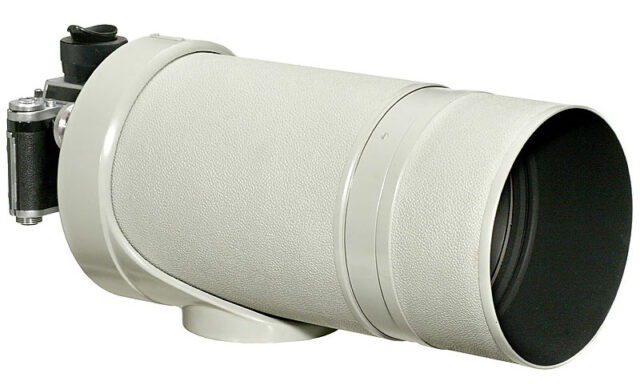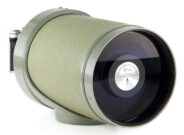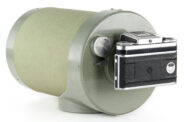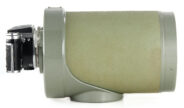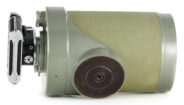Announced
Production status
Original name
Class
Pros and cons
Genres or subjects of photography
Recommended slowest shutter speed when shooting static subjects handheld
Carl Zeiss Jena DDR Spiegelobjektiv 1000mm F/5.6
Super telephoto prime lens • Film era • Discontinued
Model history
| ■Carl Zeiss Jena DDR Spiegelobjektiv 1000mm F/5.6 | -- | 4 - 3 | 16.00m | -- | 1961 ● | |
| ■Carl Zeiss Jena DDR Prakticar 1000mm F/5.6 (106 units) | -- | 4 - 3 | 16.00m | -- | ● | |
Specification


| Optical design: | |
| 1000mm | |
| F/5.6 | |
| Medium format 6x6 | |
| Praktisix (Pentacon Six) [74mm] | |
| 4.5° | |
| 4 elements in 3 groups | |
| Diaphragm mechanism: | |
Diaphragm type: | Fixed |
Aperture control: | None |
| Focusing: | |
| 16m | |
| <No data> | |
Focusing modes: | Manual focus only |
Manual focus control: | <No data> |
| Physical characteristics: | |
| 14000g | |
| ⌀?×512mm | |
| Accessories: | |
| Removable front filters are not accepted | |
| Built-in Clear, N1 - 0.5, G2, O1, R1, GR1 (part of the lens optical system) | |
| Screw-type round | |
| <No data> |
Sources of data
- Manufacturer's technical data.
- aus Jena - Photoobjektive für Exakta und Exa (1961).
- Fotoobjektive aus Jena für Exakta, Exa II, Exa I (1966).
- Photographic lenses for Exakta, Exa II, Exa I (1966).
Manufacturer description #1
SPIEGELOBJEKTIV 5,6/1000
Spezialobjektiv mit extrem langer Brennweite
- mit relativ großer Öffnung
- mit Wechseladapter
- mit eingebautem Filterrevolver
- für die 60 mm x 60 mm-Spiegelreflexkamera Pentaconsix (Anlagemaß 74,0 mm) und für Kleinbild-Spiegelreflexkameras mit Praktica-Schraubfassung M 42 x 1 (Anlagemaß 45,5 mm); mit Exakta-Bajonettfassung (Anlagemaß 44,7 mm) und mit Praktina-Steckbajonettfassung (Anlagemaß 50,0 mm)
Das SPIEGELOBJEKTIV 5,6/1000 mm ist ein Hochleistungsobjektiv für die mannigfaltigen Aufgaben von Wissenschaft und Forschung, aber auch für die dokumentarische Reportage. Bei der Konstruktion von Objektiven mit extrem langer Brenn-weite bietet die Spiegel-Linsen-Kombination gegenüber normalen Linsen-Kombinationen eine Reihe von Vorteilen. Es kann nicht nur das Öffnungsverhältnis relativ groß gehalten werden, sondern die optimale Bildleistung wird schon mit voller Öffnung erreicht.
Das SPIEGELOBJEKTIV 5,6/1000 mm zählt zu den lichtstärksten Objektiven in diesem Brennweitenbereich. Spiegelobjektive haben keine Blende. Der Einbau einer solchen wäre nicht mit den Vorteilen verbunden (größere Schärfentiefe, bessere Bild-leistung), wie dies bei herkömmlichen Objektiven der Fall ist.
***
MIRROR LENS 5.6/1000
Special lens with extremely long focal length
- with a relatively large opening
- with interchangeable adapter
- with built-in filter turret
- for the 60 mm x 60 mm Pentaconsix SLR camera (flange focal distance of 74.0 mm) and for 35mm SLR cameras with Praktica screw mount M 42 x 1 (flange focal distance of 45.5 mm); with Exakta bayonet mount (flange focal distance of 44.7 mm) and with Praktina breech-lock bayonet mount (flange focal distance of 50.0 mm)
The MIRROR LENS 5.6/1000 mm is a high-performance lens for the diverse tasks of science and research, but also for documentary reports. When designing lenses with extremely long focal lengths, the mirror-lens combination offers a number of advantages over normal lens combinations. Not only can the aperture ratio be kept relatively large, but the optimal image performance is achieved even at full aperture.
The MIRROR LENS 5.6/1000 mm is one of the brightest lenses in this focal length range. Mirror lenses have no aperture. Installing one would not offer the advantages (greater depth of field, better image performance) as is the case with conventional lenses.
Manufacturer description #2
Das seit einigen Jahren zur Auslieferung kommende Spiegelobjektiv 4/500 mm hat sich in der Praxis ausgezeichnet bewährt. Die vorzügliche Bildleistung in Verbindung mit der für f=500 mm hohen Lichtstärke 1:4 führten zu ausgezeichneten Aufnahmeergebnissen, vor allem bei solchen Anlässen, wo die herkömmlichen Fernobjektive gleicher oder ähnlicher Brennweite nur unbefriedigende Ergebnisse zeigten oder versagten.
Die Erfolge, die namhafte Tierphotographen, Zoologen, Meteorologen und andere Wissenschaftler sowie anspruchsvolle Amateure mit dem Spiegelobjektiv 4/500 mm erzielten, aber auch der oft geäußerte Wunsch nach einem Spiegelobjektiv noch längerer Brennweite veranlaßten uns zur Konstruktion des Spiegelobjektivs 5,6/1000 mm. Dieses ist sowohl für einäugige Reflexkameras 60 mm x 60 mm wie auch für Kleinbildreflexkameras vom Typ Exakta-Varex, Praktina, Pentacon und Praktica bestimmt. Es besteht aus zwei vorderen Korrektionslinsen, zwei Spiegeln und einer Feldlinse aus zwei verkitteten Linsen. Die effektive relative Öffnung 1:5,6 ist im Hinblick auf die extrem lange Brennweite relativ groß. Die Brennweite von 1000 mm ergibt beim Format 60 mm x 60 mm eine 12,5fach größere Abbildung gegenüber der Standardbrennweite 80 mm und beim Format 24 mm x 36 mm eine 20fach größere Abbildung gegenüber der Standardbrennweite 50 mm. Der Bildwinkel beträgt 5° für das Format 60 x 60 und 2,5° für das Format 24 x 36.
Die Bildgüte ist trotz der langen Brennweite hervorragend. Die Auflösung entspricht für das Format 60 x 60 der des Jena-Bm 2,8/80 mm und für das Format 24 x 36 der des Jena-T 2,8,/50 mm. Das Spiegelobjektiv 5,6/1000 mm besitzt ebenso wie das Spiegelobjektiv 4/500 mm keine Blende. Infolge der besonderen Konstruktion dieses Objektivs ist die Verwendung einer Blende nicht mit den Vorteilen verbunden, wie dies bei normalen Linsenkonstruktionen der Fall ist. Einmal läßt sich durch Abblenden die bereits vorhandene optimale Schärfe nicht weiter steigern — es würde im Gegenteil eine Minderung derselben durch Beugungserscheinungen eintreten — , zum anderen würde auch die Schärfentiefe nicht beeinflußt werden, weil beim Spiegelobjektiv die Eintrittspupille ein Kreisring ist und daher nicht die Gesetzmäßigkeiten wie für eine normale optische Konstruktion gelten. Für eine genaue Abstufung der Belichtungszeit bei Farbaufnahmen kann man das zum eingebauten Filtersatz gehörende Graufilter N1 - 0,5 benutzen, das eine feinere Unterteilung der Belichtungszeitensprünge ermöglicht.
Das Spiegelobjektiv 5,6/1000 mm ist mit einem eingebauten Filterrevolver mit fünf verschiedenen Filtern und einer klaren Planglasscheibe ausgestattet. Diese gleicht die optische Weglänge bei Nichtgebrauch der Filter aus.
Die Entfernungsteilung erlaubt Aufnahmen von Unendlichkeit bis 16 m. Für die Anpeilung des Objektes ist ein Grobvisier angebracht, das besonders bei Kleinbildaufnahmen die Motiverfassung erleichtert. Das Objektiv ist kurz und gedrungen gebaut, die optische Baulänge beträgt 406 mm = 42 % der Brennweite.
Bedienungshinweise
Das Spiegelobjektiv 5,6/1000 mm soll nur in Verbindung mit einem sehr stabilen Stativ, dessen Kopf einen drehbaren 3/8"-Normgewindezapfen aufweist, benutzt werden. Für die Anwendung an Kleinbildreflexkameras vom Typ Exakta-Varex, Praktina, Pentacon und Praktica sind Übergangsringe vorgesehen, die sich mit Steckbajonett am Objektiv befestigen lassen. Diese Übergangsringe werden zum Objektiv mitgeliefert.
Die Fokussierung geschieht mit dem rechten Einstellknopf. Vor der Scharfeinstellung wird das Objekt zweckmäßig mit dem Grobvisier auf der Oberseite des Objektivs angepeilt. Zum Einstellen der Bildschärfe ist der links befindliche Klemmhebel durch Hochdrücken zu lösen. Nach erfolgter Einstellung wird dieser durch Friktion festgehalten.
Die im Revolver fest eingebauten Filter bringt man durch Drehen des linken Einstellknopfes (in Pfeilrichtung) in den Strahlengang, dabei ist der Drehknopf zunächst leicht anzuheben und dann nach links zu drehen (Rechtsdrehen des Knopfes ist nicht möglich). Nach einer halben Umdrehung tritt selbsttätig eine Rastung ein, hiermit ist das jeweils dem Index gegenüberstehende Filter vorgeschaltet.
Reihenfolge der Filter - Verlängerungsfaktor
1. Planglas klar - 1
2. Filter N1 - 0,5 = Neutralgrau mit 25%iger Absorption - 1,5
3. Filter G2 = Gelb-dunkel - etwa 2
4. Filter O1 = Orange - etwa 2,5
5. Filter R1 = Rot-hell - etwa 10
6. Filter GR1 = Gelbgrün - etwa 2,5
Make und Gewicht
Gesamtbaulänge
bei Format 60 mm x 60 mm - 465 mm
bei Format 24 mm x 36 mm (Exakta-Varex) - 494 mm
bei Format 24 mm x 36 mm (Praktina) - 496 mm
bei Format 24 mm x 36 mm (Pentacon, Praktica) - 495 mm
(alle Längen mit Sonnenblende)
Größter Durchmesser (ohne Fuß) - 240 mm
Schnittweite (s') - 80,48 mm.
Gewicht - etwa 14 kg.
***
The 4/500 mm mirror lens, which has been available for delivery for several years, has proven itself excellently in practice. The excellent image performance in conjunction with the high speed of 1:4 for f=500 mm led to excellent shooting results, especially on occasions where conventional long-distance lenses of the same or similar focal length only showed unsatisfactory results or failed.
The successes that well-known animal photographers, zoologists, meteorologists and other scientists as well as demanding amateurs achieved with the 4/500 mm mirror lens, but also the often expressed desire for a mirror lens with an even longer focal length, led us to design the 5.6/1000 mm mirror lens. This is intended for 60 mm x 60 mm single-lens reflex cameras as well as for 35mm reflex cameras of the Exakta-Varex, Praktina, Pentacon and Praktica types. It consists of two front correction lenses, two mirrors and a field lens made of two cemented lenses. The effective relative aperture of 1:5.6 is relatively large considering the extremely long focal length. The focal length of 1000 mm results in an image that is 12.5 times larger than the standard focal length of 80 mm for the 60 mm x 60 mm format and 20 times larger than the standard focal length of 50 mm for the 24 mm x 36 mm format. The image angle is 5° for the 60 x 60 format and 2.5° for the 24 x 36 format.
The image quality is excellent despite the long focal length. The resolution corresponds to that of the Jena-Bm 2.8/80 mm for the 60 x 60 format and to that of the Jena-T 2.8/50 mm for the 24 x 36 format. The 5.6/1000 mm mirror lens, like the 4/500 mm mirror lens, has no aperture. Due to the special design of this lens, the use of an aperture does not come with the benefits of normal lens designs. On the one hand, the already existing optimal sharpness cannot be further increased by stopping down - on the contrary, it would be reduced due to diffraction phenomena - and on the other hand, the depth of field would not be influenced because the entrance pupil of the mirror lens is a circular ring and therefore does not follow the same laws apply to a normal optical construction. For a precise gradation of the exposure time for color photographs, you can use the N1 - 0.5 gray filter that is part of the built-in filter set, which enables a finer adjustment of the exposure time.
The 5.6/1000mm mirror lens is equipped with a built-in filter turret with five different filters and a clear flat glass plate. It compensates the length of the optical path when the filters are not in use.
The distance scale allows shooting from infinity up to 16 m. A coarse sight is attached to aim at the object, which makes it easier to capture the subject, especially when taking 35mm images. The lens is short, the optical length is 406 mm = 42% of the focal length.
Operating instructions
The 5.6/1000 mm mirror lens should only be used in conjunction with a very stable tripod whose head has a rotatable 3/8" standard threaded pin. For use on 35mm reflex cameras of the Exakta-Varex, Praktina, Pentacon and Praktica types adapter rings are provided, which can be attached to the lens using a plug-in bayonet. These adapter rings are included with the lens.
Focusing is done with the right adjustment knob. Before focusing, it is advisable to focus on the object using the coarse sight on the top of the lens. To adjust the image sharpness, release the clamping lever on the left by pushing it up. Once adjusted, it is held in place by friction.
The filters, which are permanently installed in the revolver, are brought into the light path by turning the left adjustment knob (in the direction of the arrow). The knob must first be lifted slightly and then turned to the left (turning the knob to the right is not possible). After half a turn, a detent occurs automatically.
Order of filters - Exposure factor
1. Clear glass plate - 1
2. Filter N1 - 0.5 = Neutral gray with 25% absorption - 1.5
3. Filter G2 = Dark-yellow - about 2
4. Filter O1 = Orange - about 2.5
5. Filter R1 = Light-red - about 10
6. Filter GR1 = Yellow-Green - about 2.5
Make and weight
Overall length
for 60 mm x 60 mm format - 465 mm
for 24 mm x 36 mm format (Exakta-Varex) - 494 mm
for 24 mm x 36 mm format (Praktina) - 496 mm
for 24 mm x 36 mm format (Pentacon, Praktica) - 495 mm
(all lengths with shade)
Largest diameter (without tripod foot) - 240 mm
Back focal length (s') - 80,48 mm.
Weight - approximately 14 kg.
Manufacturer description #3
Wechseladapter ermöglichen die Objektive ab 135 mm Brennweite mit mehreren Aufnahmegeräten zu benutzen. Das erspart den Kauf und den Transport zusätzlicher langbrennweitiger Objektive für die zweite oder gar dritte Kamera. Für sie ist lediglich ein preisgünstiger und leichter Wechseladapter nötig. Die ZEISS-Objektive SONNAR 2,8/180 und 4/300 sowie das Spiegelobjektiv 5,6/1000 sind mit Wechseladapter der Kleinbildkameras ausgerüstet, werden jedoch für die PENTACON six TL und PRAKTISIX ohne diesen Wechseladapter benutzt.
Die Objektive SONNAR 2,8/180 und 4/300 können mit einem Elektrik-Adapter für die elektrische Blendenwertübertragung der dafür vorgesehenen PRAKTICA-Typen ergänzt werden.
***
Interchangeable adapters enable the lenses with a focal length of 135 mm or more to be used with multiple recording devices. This saves you from buying and transporting additional long focal length lenses for the second or even third camera. All you need is an inexpensive and lightweight interchangeable adapter. The ZEISS SONNAR 2.8/180 and 4/300 lenses as well as the mirror lens 5.6/1000 are equipped with an interchangeable adapter for the 35mm cameras, but are used on the PENTACON six TL and PRAKTISIX without this interchangeable adapter.
The SONNAR 2.8/180 and 4/300 lenses can be supplemented with an electrical adapter for the electrical aperture value transmission of the PRAKTICA types intended for this purpose.
From the Monthly Abstract Bulletin from the Kodak Research Laboratories (1961)
A new long-focus mirror lens designed for use with negatives 6 by 6 cm. or smaller, introduced by VEB Carl Zeiss, in Jena, has a focal length of 40 in. (1000 mm.) and an aperture of f/5.6. It is only 16 in. long and weighs 26 1/2 lb.
From the Photographic Abstracts (1964)
An f/5.6, 1,000 mm. catadioptric objective is made by Carl Zeiss Jena for mirror cameras with frame sizes of 60 x 60 mm. and 24 x 36 mm. The angle of field of the image is 5° for a frame size of 60 x 60 mm. and 2.5° for a frame size of 24 x 36 mm. The objective does not have a diaphragm and is provided with a rotating filter holder.
Typical characteristics of mirror (reflex) lenses
- Catadioptric system consisting of curved mirrors and optical glass;
- Much shorter, lighter and less expensive designs than conventional super telephoto lenses;
- Outstanding correction of chromatic aberrations;
- Since the aperture is fixed, neutral density filters are used to obtain a smaller aperture;
- Doughnut-shaped out-of-focus highlights.
From the editor
The lens had a Praktisix (Pentacon Six) bayonet mount, but interchangeable adapters were available for Exakta-Varex, Praktina, Pentacon / Praktica 35mm SLR cameras.
The overall length is indicated with a lens hood.
Lenses with similar focal length
| ■Praktisix (Pentacon Six) mount (1) | |||||||||
| Carl Zeiss Jena DDR Prakticar 1000mm F/5.6 (106 units) | -- | 4 - 3 | 16.00m | -- | ● | ||||
